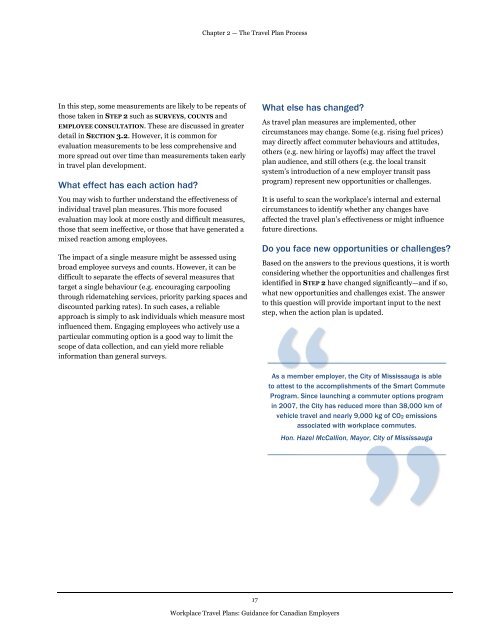Workplace Travel Plans - main body - Final Jan 2010 ENGLISH - FCM
Workplace Travel Plans - main body - Final Jan 2010 ENGLISH - FCM
Workplace Travel Plans - main body - Final Jan 2010 ENGLISH - FCM
You also want an ePaper? Increase the reach of your titles
YUMPU automatically turns print PDFs into web optimized ePapers that Google loves.
Chapter 2 — The <strong>Travel</strong> Plan Process<br />
In this step, some measurements are likely to be repeats of<br />
those taken in STEP 2 such as SURVEYS, COUNTS and<br />
EMPLOYEE CONSULTATION. These are discussed in greater<br />
detail in SECTION 3.2. However, it is common for<br />
evaluation measurements to be less comprehensive and<br />
more spread out over time than measurements taken early<br />
in travel plan development.<br />
What effect has each action had?<br />
You may wish to further understand the effectiveness of<br />
individual travel plan measures. This more focused<br />
evaluation may look at more costly and difficult measures,<br />
those that seem ineffective, or those that have generated a<br />
mixed reaction among employees.<br />
The impact of a single measure might be assessed using<br />
broad employee surveys and counts. However, it can be<br />
difficult to separate the effects of several measures that<br />
target a single behaviour (e.g. encouraging carpooling<br />
through ridematching services, priority parking spaces and<br />
discounted parking rates). In such cases, a reliable<br />
approach is simply to ask individuals which measure most<br />
influenced them. Engaging employees who actively use a<br />
particular commuting option is a good way to limit the<br />
scope of data collection, and can yield more reliable<br />
information than general surveys.<br />
What else has changed?<br />
As travel plan measures are implemented, other<br />
circumstances may change. Some (e.g. rising fuel prices)<br />
may directly affect commuter behaviours and attitudes,<br />
others (e.g. new hiring or layoffs) may affect the travel<br />
plan audience, and still others (e.g. the local transit<br />
system’s introduction of a new employer transit pass<br />
program) represent new opportunities or challenges.<br />
It is useful to scan the workplace’s internal and external<br />
circumstances to identify whether any changes have<br />
affected the travel plan’s effectiveness or might influence<br />
future directions.<br />
Do you face new opportunities or challenges?<br />
Based on the answers to the previous questions, it is worth<br />
considering whether the opportunities and challenges first<br />
identified in STEP 2 have changed significantly—and if so,<br />
what new opportunities and challenges exist. The answer<br />
to this question will provide important input to the next<br />
step, when the action plan is updated.<br />
As a member employer, the City of Mississauga is able<br />
to attest to the accomplishments of the Smart Commute<br />
Program. Since launching a commuter options program<br />
in 2007, the City has reduced more than 38,000 km of<br />
vehicle travel and nearly 9,000 kg of CO2 emissions<br />
associated with workplace commutes.<br />
Hon. Hazel McCallion, Mayor, City of Mississauga<br />
17<br />
<strong>Workplace</strong> <strong>Travel</strong> <strong>Plans</strong>: Guidance for Canadian Employers

















